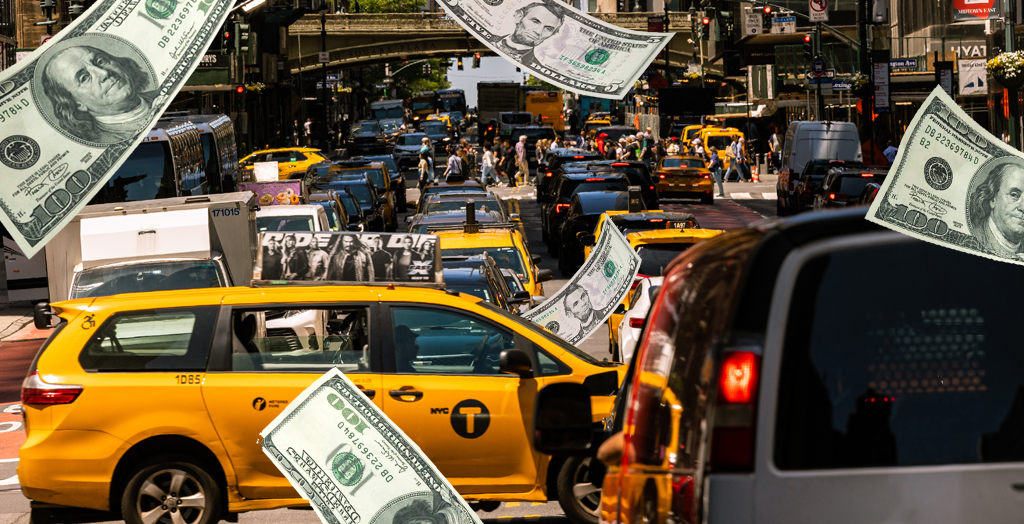Tens of millions of dollars earmarked for transit improvements are still sitting untouched in a transit improvement fund controlled by state legislators even as congestion pricing is set to begin in just two months.
A surcharge on taxi rides that's supposed to pay for up to $50 million in transit improvements outside of Manhattan every year still has a balance of more than $45 million after the MTA approved two service enhancements on Monday: increased service on five Brooklyn and Staten Island express bus lines (BM2, BM5, SIM1C, SIM4C, SIM23, and SIM24), and a 10-percent discount on monthly intracity tickets on the Long Island Rail Road and Metro-North.
The extra bus service and the ticket discounts were both funded by the Outer Borough Transit Account, a fund established in 2018 when New York State added the taxi surcharge in Manhattan.
The first $300 million raised by the surcharge every year goes towards subway maintenance, and the next $50 million is supposed to go to the OBTA, a fund controlled by the governor and legislators that's earmarked for targeted transit investments to outside Manhattan, the "carrots" compared to the "stick" of congestion pricing.
Before the pandemic, when it looked like congestion pricing might start in 2021, legislators announced a series of improvements including additional bus service on a handful of lines, ticket discounts on the LIRR and Metro-North and a late-night microtransit pilot for some neighborhoods. But the pandemic upended travel patterns in lower Manhattan and the surcharge didn't raise more than $300 million for the first couple of years.
As the city recovered though, the fund became flush. Before Monday, the outer borough transit fund only underwrote toll rebates for Queens residents driving on the Cross Bay Bridge, Bronx residents driving on the Henry Hudson Bridge and Staten Island residents driving on the Verrazzano Bridge, at a cost of $22.2 million.
The discounted monthly tickets cost $4 million, and the additional express bus service costs $883,000 out of the OBTA according to the MTA.
That leaves about $23 million the fund raised in 2023 for legislators to improve service for their constituents. But the fund has an additional $39 million to be spent on capital improvements outside of Manhattan.
"That money in the OBTA could, potentially buy new buses, and shouldn't be left on the table," said Riders Alliance Director of Policy and Communications Danny Pearlstein. "This money isn't meant to be lockboxed for no reason. It's meant to be spent to improve the quality of public transit in New York."
Other advocates see the money as a path to keep alive previous priorities, like a pilot for a weekly City Ticket with a free transfer to the bus or subway. Currently, City Ticket offers $5 off-peak/$7 peak tickets for intracity LIRR and Metro-North rides.
"Not everybody can shell out for monthly, which is why we still are looking for a weekly City Ticket," said Lisa Daglian, the executive director of the Permanent Citizens Advisory Committee to the MTA.
Of course, it's not fully clear if there is $62 million in the fund or a bit less, thanks to confusing Albanynomics.
The state Assembly took credit for the LIRR and Metro-North ticket discounts in a press release after the budget was approved in mid-April, but the source of the money for the discounts isn't in the budget, and was a total mystery until Monday's announcement by the MTA. But that press release also highlighted expanded bus service on seven express bus routes and 13 local routes, which was another transit improvement that was not attached to a specific budget line. The money paying for those improvements most likely comes from the OBTA, said one source.
If so, the improvements announced on Monday, which are pegged at $16.3 million in the press release, would still leave close to $46 million left in the account from 2022 and 2023.
Government watchdogs are frustrated by the lack of clarity, especially since the projects funded by the OBTA are supposed to be approved by a public vote of the Capital Program Review Board, which is normally a four-person panel comprised of one appointee each by the governor, the mayor, the state Senate and the Assembly but in the case of the OBTA only involves the three state representatives.
"The more scrutiny and daylight on these items, the more likely we are to get a more balanced list that doesn't benefit drivers more than riders," said Reinvent Albany Senior Policy Advisor Rachael Fauss. "If you had to look at them in totality, the toll rebates may not have been seen in as good as transit projects."






